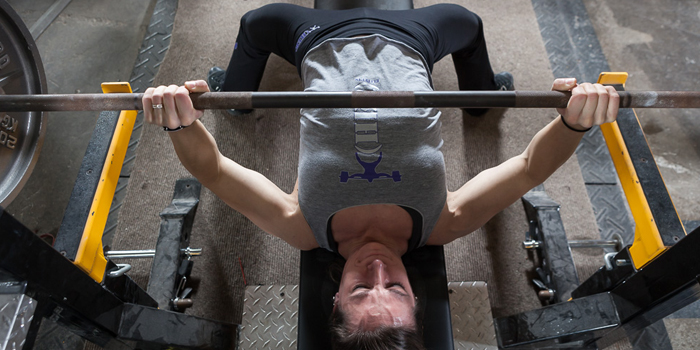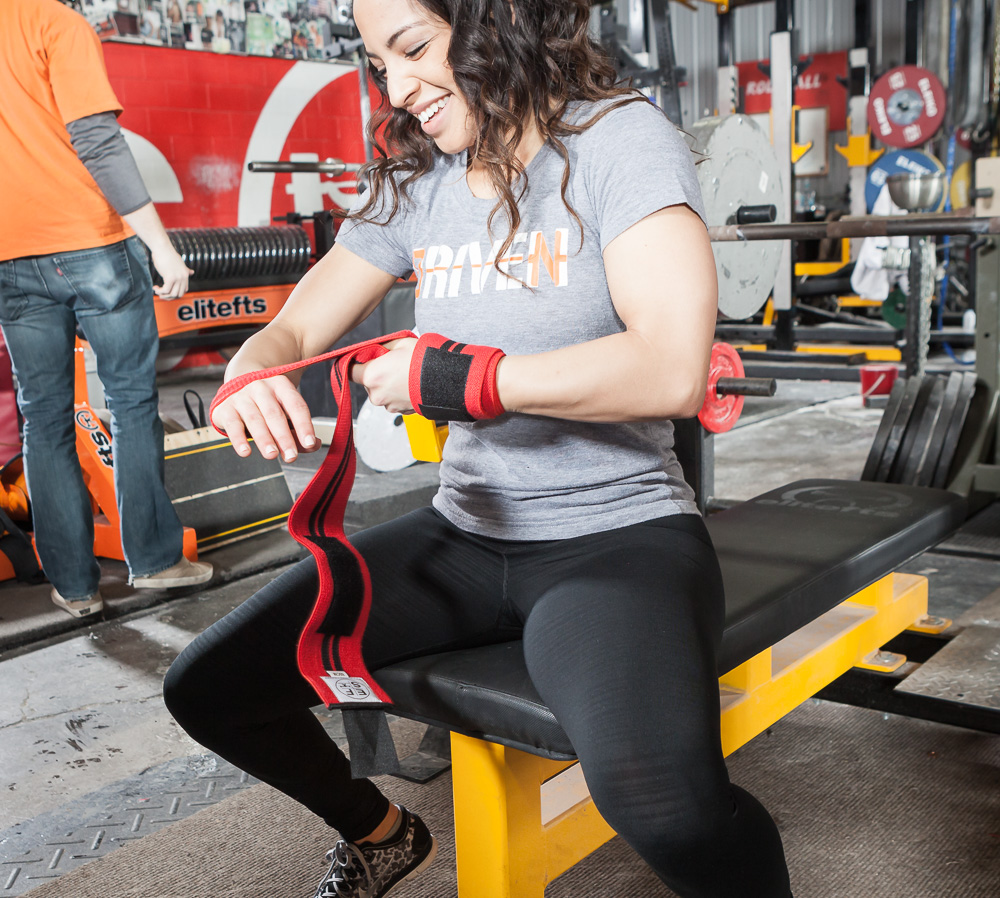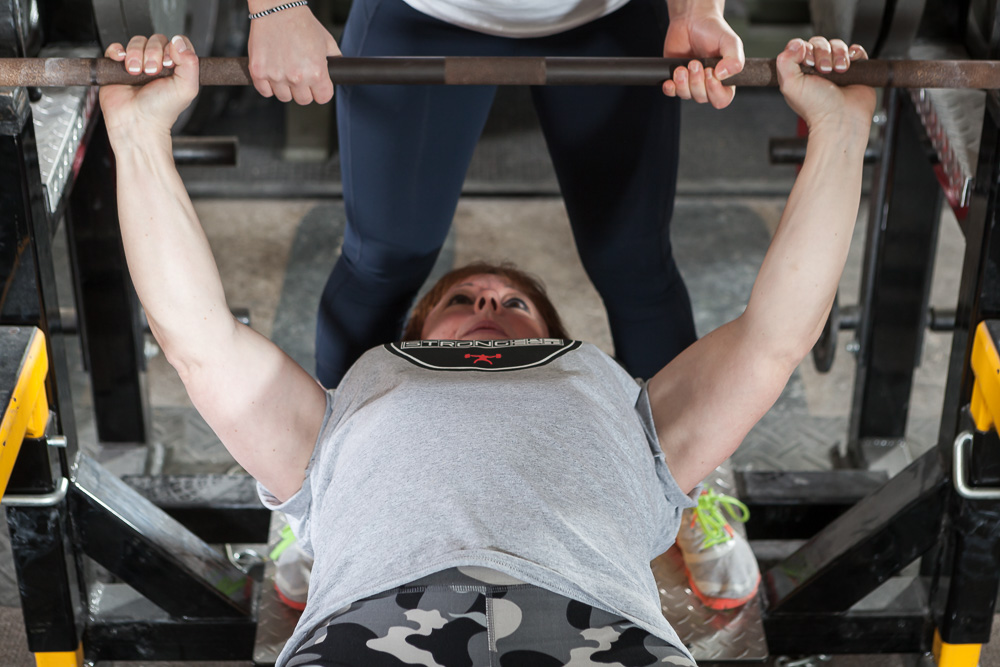
In years past, when you walked into a college weight room, the benches and squat racks were primarily dominated by males. But times have changed. Now when you walk into a college weight room, females are lifting heavy and many are lifting more than the guys! This article is written to provide coaching ideas and progressions for teaching female lifters who are interested in entering the weight room (possibly for the first time).
In my last article, I discussed squat progressions for the novice female lifter and coaching considerations for working with a group of beginners. I used examples from the Bobcat BarBelles Women’s Strength Training Program that I run at Ohio University, which is comprised of 35 college age females who took the fall semester to learn the core barbell movements (squat, bench press, deadlift and overhead press). The program broke up the women into small groups and taught each of the movements once per week for two weeks.
When we surveyed the women before beginning the program, the majority of them identified as having very little knowledge of the bench press (with the rest of the responses falling between “no knowledge” and “fair amount of knowledge” with the lift). Over 50 percent of the women also said that they weren’t comfortable lifting in the weight room. This, combined with the above inexperience in the lifts, required that we tailor the coaching so we could teach them quickly (under the time constraints of coaching them once per week) and progress things in a way that instilled confidence, taught proper technique and addressed physical weaknesses.
RECENT: Strong(her) Squat Progressions for the Novice Female Lifter
In the last article, I discussed the importance of the following coaching considerations for working with a group of beginners like this one:
- Give all the lifters a “coaching” role. Teach them to properly spot, give coaching cues and encourage the rest of the group at all times.
- Give constructive but honest feedback. Be encouraging, but don’t coddle anyone. Empowerment comes from raising expectations, not lowering them.
- Utilize technique and movement pattern drills during the warm up. Make sure that warm ups instill good patterns and habits in order to make the most of your time with each group.
- Utilize exercises and drills to improve technique, and address weaknesses in between working sets. For example, use goblet squats to work on proper depth and confidence.
- Keep cues simple, and keep the big picture in mind. With novice lifters and limited time, make sure to choose your coaching cues wisely so that the lifters can easily remember/understand them. Use the coaching cues for each other outside of your coaching sessions. Also, make sure to emphasize big principles like consistency and progressive overload in training. Don't get too bogged down with the details of complicated programming.
We took the above approach when we taught the squat, and after two weeks of coaching and getting the lifters acclimated to the weight room (many had never lifted in it before), we were ready to move on to the bench press.
Building Blocks for a Strong(her) Bench Press
When beginning to coach the bench press, we started by going through our standard, dynamic warm up (basic movements like arm circles, wall squats, etc.). Then we used the following movements to cue movement and warm up further before we performed the actual bench press:
- Band pull-aparts: These were used to cue lat tightness and teach the lifters to pull their shoulder blades together and down (like they will when performing the bench press).
- Wall push-ups: These were used to teach proper elbow position when lowering down for a push-up (or bench press). Many participants were used to keeping their elbows very wide and up by their ears, so we taught them to keep their elbows tucked and their shoulder blades together as they lowered down and then pressed up.
- Floor push-ups: We did a few short sets to further the warm up and emphasize elbow position.
- Bench setup with PVC pipe: This was only done the first week. In order to teach bench press setup, we had the lifters practice setting up with their shoulder blades tucked and their legs tight and a tight squeeze on the “bar” using a PVC pipe. Then we had them “break the bar” to practice lat tightness and do a few reps to practice bar path. This shouldn’t be overdone, but 1–2 quick sets can help with extra practice on setup (particularly when some of the women’s maxes weren't much higher than the empty barbell initially). The more “first reps” the better, so finding low intensity ways to do more sets is key.
After performing the above progressions, we had the group do about 3–5 sets of 1–3 reps with the empty barbell in order to practice setup, technique and “first reps.” When teaching a new movement, this is more beneficial than just performing 1–2 sets of 10 reps or more and fatiguing the lifters to a point where they can’t continue to practice technique (and reducing the amount of sets automatically reduces the number of times they practice their setup). You don't want to take jumps too quickly, particularly if the lifter’s current maxes aren’t much more than the empty barbell (which was the case with many of our novice females). This is an area where far too many coaches and trainers make mistakes and waste opportunities for further technique refinement.
In the second week, we performed the movement with a reduced number of sets. This is always dependent on how the lifter is progressing and is customized to the strength of the lifter and a percentage of her max. Weight jumps are also affected by this. Remember that a 10-pound jump for a lifter who benches 400 pounds is only 2.5 percent (and we can easily think of it as “only 10 pounds”). But for a lifter who is benching for the first time and has a max of 85 pounds, 10 pounds is already over 11 percent of her max. Always make sure that the weight jumps you take in warm ups reflect the strength level of the lifter you’re coaching or the overall volume will suffer. This is one of the reasons why many coaches prescribe more set volume for a female than a male. Female lifters naturally do less volume when working up to the prescribed percentages, max or other intensity level for that day.
As with other movements, coaching cues were very important when teaching the bench press. Some of the instructions we began with right off the bat were:
- Set up on the bench with the shoulder blades pulled down and together and pressed down into the bench.
- Grip the barbell evenly and slightly wider than shoulder width (we then adjusted individually).
- Get the feet directly underneath knee position to start.
- Get everything tight (squeeze bar, squeeze lats, press feet into shoes, etc.).
- Take the barbell out until it is directly over the lower chest and then pause to let the bar “settle” before lowering.
- Lower the bar to the bottom of the chest. (The cue that worked the best for every female lifter was “lower to the bottom of your sports bra.” This was a cue that I wouldn’t have thought of until my graduate assistant Jenny suggested it. It worked better than anything else I had used before.)
These lengthier descriptions of technique are great when teaching the lift initially, but when performing the lift, cues need to be shorter and more precise in order for them to work and be easily used by the lifters to help each other.
Here are some examples of the cues we used during the actual sets:
- “Everything tight” (fixes a multitude of other issues).
- “Shoulders down” (used to maintain tucked lat position).
- “Squeeze the bar” (used to keep upper body tight).
- “Knuckles up” (used to keep wrists straight).
- “Knees out” (used to keep legs tight).
- “Let the bar settle” (used to encourage patience and keep them from “dive bombing” the bench).
- “Elbows straight down” (used to prevent over-tucking of the elbows during the eccentric part of the bench).
- “Chest to the bar” (used to they met their chests to the bar as they lowered it down).
- “Back to (name of spotter)”(helps lifters remember to press in a good groove as opposed to out over their stomachs).
As the sets continued, technique improved and confidence grew (both in performing the lift and in the weight room). We encouraged the lifters to utilize time outside of our coaching sessions to work on their technique and coach each other using the cues they had learned. Toward the end of the semester, we also discussed programming and how to create a program (and how to determine whether one they are given is good or not). I'll cover this in a future article. When initially teaching beginner lifters, it's important to focus on technique and consistency and build confidence. The rest will fall into place if these are done correctly.












